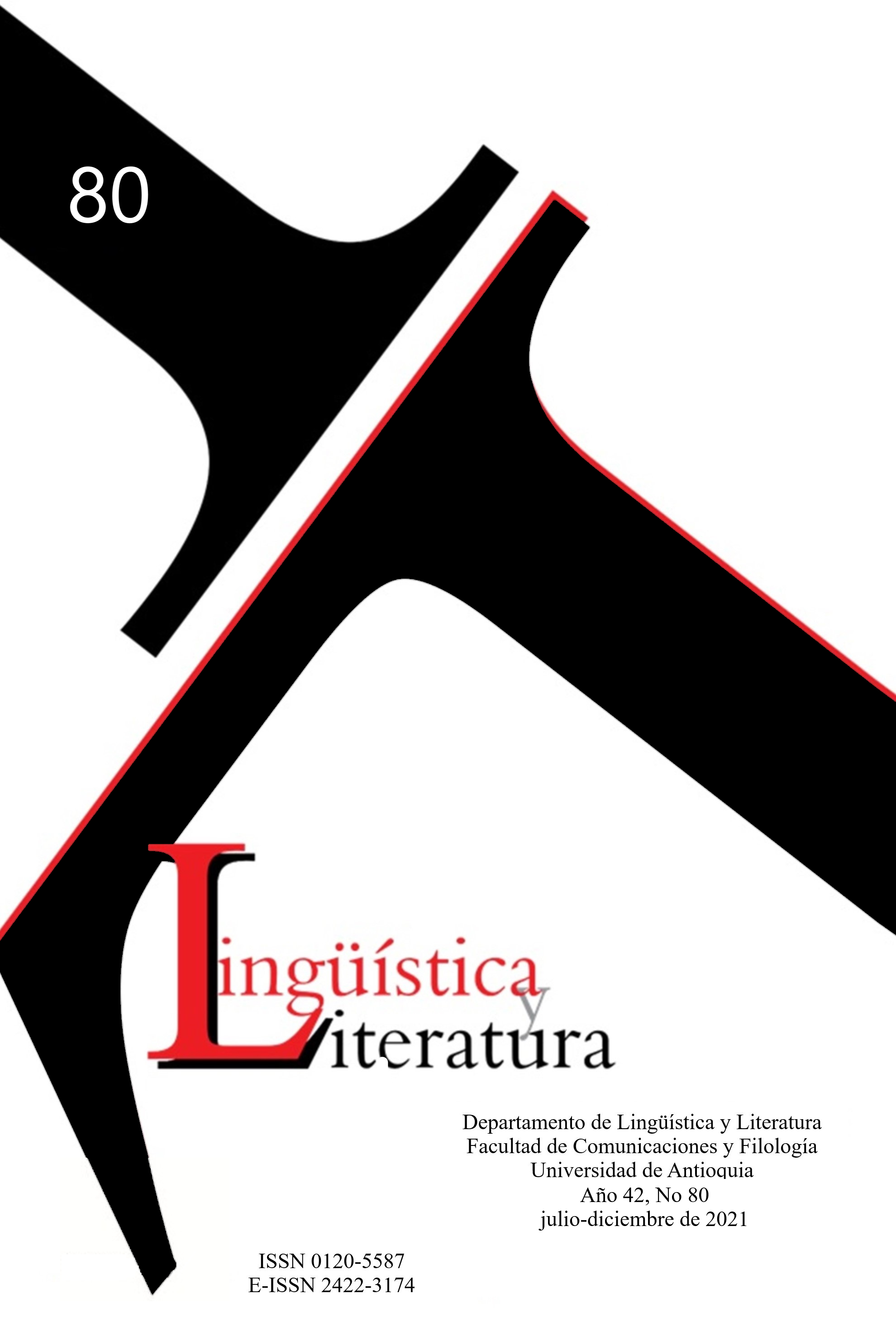Polifuncionalidad de la nominalización en exposiciones escritas de niños y adolescentes de Córdoba (Argentina)
DOI:
https://doi.org/10.17533/udea.lyl.n80a12Palabras clave:
nominalización, función discursivo-textual, exposición escrita, alfabetización lingüística, ontogenia del lenguajeResumen
Se realizó un estudio descriptivo sobre las operaciones discursivo-textuales de las nominalizaciones en exposiciones producidas por estudiantes de nivel primario y secundario. Se recolectaron sesenta textos en una escuela privada de Córdoba (Argentina), en los cuales se analizaron, con base en Soto y Zenteno (2004), la identificación de referentes, la predicación, la textualización y la organización jerárquica de la información como indicadores del desarrollo del lenguaje. La evidencia empírica constata la hipótesis de que existe un vínculo estrecho entre la ontogenia de estas funciones nominales y el avance de los estudiantes en el proceso de alfabetización lingüística.
Descargas
Citas
Albentosa, J. I. y Moya, A. J. (2000). La reducción del grado de transitividad de la oración en el discurso científico en lengua inglesa. Revista Española de Lingüística, 30(2), 445-468.
Bassols, M. y Torrent, A. M. (2012). Modelos textuales. Teoría y práctica. Barcelona: Octaedro.
Berman, R. & Slobin, D. (1994). Relating Events in Narrative: A Crosslinguistic Development Study. New Jersey: Lawrence Erlbaum.
Berman, R., Ragnarsdóttir, H. & Strömqvist, S. (2002). Discourse Stance. Written Language and Literacy, 5, 255-290.
Biber, D. (1988). Variation Across Speech and Writing. Cambridge: Cambridge University Press.
Canale, M. (1983). From Communicative Competence to Language Pedagogy. En J. C. Richards & J. Schdmit (Eds.), Language and Communication (pp. 2-27). London: Longman.
Canale, M. & Swain, M. (1980). Theoretical Basis of Communicative Approaches to Second Language Teaching and Testing. Applied Linguistics, 1, 1-47.
Di Tullio, A. (2010). Manual de gramática del español. Buenos Aires: Waldhuter.
Halliday, M. (1993). Towards a Language-Based Theory of Learning. Linguistics and Education, 5, 93-116.
Halliday, M. & Martin, J. (1993). Writing Science: Literacy and Discursive Power. London: Falmer Press.
Hernández Sampieri, R., Fernández Collado, C. y Baptista Lucio, P. (2010). Metodología de la investigación. México: McGraw Hill.
Hess Zimmerman, K. (2013). Desarrollo léxico en la adolescencia: un análisis de sustantivos en narraciones orales y escritas. Actualidades en Psicología, 115(27), 113-127.
Hyland, K. (2005). Postura y afiliación: un modelo de interacción en el discurso académico. Discourse Studies, 7(2), 173-192.
IBM Corp. (2011). IBM SPSS Statistics para Windows, Versión 20. New York: IBM Corp.
Katzenberger, I. (2004). The Development of Clause Packaging in Spoken and Written Texts. Journal of Pragmatics, 36, 1921-1948.
Lyons, J. (1980). Semántica. Barcelona: Teide.
Nippold, M. (2004). Research on Later Language Development. International Perspectives. In R. Berman (Ed.), Language Development Across Childhood and Adolescence (pp. 1-8). Philadelphia: John Benjamins.
Nippold, M. (2007). Later Language Development: School-Age Children, Adolescents, and Young Adults. Austin: Pro-Ed.
Nir-Sagiv, B. & Berman, R. (2010). Complex Syntax as a Window on Contrastive Rhetoric. Journal of Pragmatics, 42(3), 744-765.
Parodi, G. (2009). Corpus, discurso y géneros: español en contextos académicos y profesionales. En A. Vera Luján y I. Martínez Martínez (Eds.), El español en contextos específicos: enseñanza e investigación (pp. 65-88). Comillas: Fundación Comilla y ASELE.
Picallo, M. (1999). La estructura del sintagma nominal: las nominalizaciones y otros sustantivos con complementos argumentales. En I. Bosque y V. Demonte (Dirs.), Gramática descriptiva de la lengua española, Vol. i (pp. 363-393). Madrid: Espasa.
RAE-ASALE (2009). Nueva gramática de la lengua española. Madrid: Espasa.
Ravid, D. (2004). Emergence of Linguistic Complexity in Later Language Development: Evidence from Expository Text Construction. In D. Ravid & H. Bat-Zeev Shyldkrot (Eds.), Perspectives on Language and Language Development. Essays in Honor of Ruth A. Berman (pp. 337-355). Boston: Kluwer Academic Publishers.
Ravid, D. (2006). Semantic Development in Textual Contexts during the School Years: Noun Scale Analyses. Journal of Child Language, 33, 791-821.
Ravid, D. & Avidor, A. (1998). Acquisition of Derived Nominals in Hebrew: Developmental and Linguistic Principles. Journal of Child Language, 25, 229-266.
Ravid, D. & Berman, R. (2010). Developing Noun Phrase Complexity at School Age: A Text-Embedded Cross-Linguistic Analysis. First Language, 30(1), 3-26.
Ravid, D. & Cahana-Amitay, D. (2005). Verbal and Nominal Expressions in Narrating Conflict Situations in Hebrew. Journal of Pragmatics, 37, 157-183.
Ravid, D. & Tolchinsky, L. (2002). Developing Linguistic Literacy: A Comprehensive Model. Journal of Child Language, 29, 417-447.
Silvestri, A. (2000). Los géneros discursivos escolares: un aprendizaje discursivo y cognitivo. Lenguajes: teorías y prácticas. Buenos Aires: Secretaría de Educación.
Silvestri, A. (2002). La concepción sociogenética del proceso de enseñanza/aprendizaje: implicancias educativas. Lingüística en el Aula, 5, 49-58.
Soto, G. y Zenteno, C. (2004). Los sintagmas nominales en textos científicos escritos en español. Estudios de Lingüística, 18, 275-292.
Zenteno, C. (1996). La tendencia entificatoria en el discurso del especialista. En M. Rodríguez y M. A. Farías (Eds.), Investigación multidisciplinaria. Estrategias integradas de investigación en lingüística, literatura y disciplinas afines. Santiago: Universidad de Santiago de Chile.
Wells, G. (2004). El papel de la actividad en el desarrollo y la educación. Infancia y aprendizaje, 27(2), 165-187.
Publicado
Versiones
- 2021-11-14 (2)
- 2021-07-30 (1)
Cómo citar
Número
Sección
Licencia
Derechos de autor 2021 Lingüística y Literatura

Esta obra está bajo una licencia internacional Creative Commons Atribución-NoComercial-CompartirIgual 4.0.
Creative Commons by-nc-sa
Aquellos autores/as que tengan publicaciones con esta revista, aceptan los términos siguientes:
1. La revista es el titular de los derechos de autor de los artículos, los cuales estarán simultáneamente sujetos a la Licencia Internacional Creative Commons Reconocimiento-NoComercial-CompartirIgual 4.0. que permite a terceros compartir la obra siempre que se indique su autor y su primera publicación en esta revista.
2. Los autores/as podrán adoptar otros acuerdos de licencia no exclusiva de distribución de la versión de la obra publicada (p. ej.: depositarla en un archivo telemático institucional o publicarla en un volumen monográfico) siempre que se indique la publicación inicial en esta revista.
3. Se permite y recomienda a los autores/as difundir su obra a través de Internet (p. ej.: en archivos telemáticos institucionales o en su página web) antes y durante el proceso de envío, lo cual puede producir intercambios interesantes y aumentar las citas de la obra publicada.










